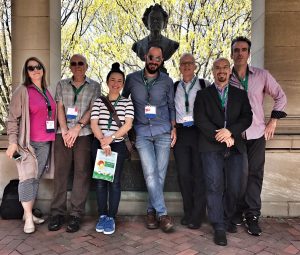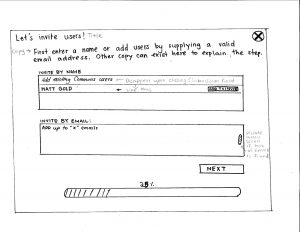The Humans Behind the Machines: Spotlight on the People & Processes Keeping the Commons Going

Welcome fellow Commoners!
Most weeks I write about new and interesting work people are sharing on the Commons. In this vast, open, shareable space we call the Commons, people from across CUNY experiment, collaborate and create in unexpected ways all the time. This week, though, I want to offer you a glimpse into what goes on behind the scenes. The Commons is, after all, an ongoing experiment in creating more open and transparent digital spaces for the CUNY system. It forges ahead thanks to the efforts of many dedicated people: programmers, designers, technicians, librarians, faculty, students, project-managers, and community leaders. This post is, in a small way, a thank you to all of them. Below you’ll read about howthese folks work together to brainstorm, design, and implement changes that help support the Commons and there are many more people than are named in this post. But hopefully we’ll get to everyone (including readers and content creators like you) through future posts and behind-the-scenes glimpses.
If you’ve been reading this blog the past few weeks, you’ll know that the Commons is preparing a new on-boarding module that is designed to make it easier to teach graduate and undergraduate courses on the Commons.. But how did this major upgrade get started in the first place? This post will shed light on the people and networks that support the Commons by following the development of the on-boarding module from start to finish.
The process began a year ago when members of the CUNY Academic Commons Subcommittee (the decision-making brain trust behind the Commons) brainstormed new ways to keep getting the word out about the Commons. The Commons began as a community of CUNY faculty, staff and graduate students, largely because of limited resources. Since then, the Commons has been opened to undergradaute students making free digital space open to all CUNY students even if there is no WordPress multisite platform at their home campus (such as Blogs@Baruch, Qwriting or City Tech Open Lab).
In the Subcommittee meeting, Michael Smith (professor at York College, artist, lover of kittens) floated the idea of Faculty Fellows program to encourage CUNY instructors to experiment with creative teaching methods on the Commons. These faculty members could blog about their experiments, successes and frustrations hopefully inspiring others and helping people just dipping their toes into the digital waters to avoid common pitfalls. As a side benefit, these intrepid faculty could help the subcommittee identify ways to make the Commons more teaching-friendly. It’s the type of idea that embodies the “share and share alike” ethos of the Commons. Even in a windowless conference room in the bowels of the Graduate Center, the subcommittee members buzzed with excitement.
To get the Faculty Fellows program off the ground, Michael joined forces with fellow subcommittee member Luke Waltzer (professor at The Graduate Center, Director of the GC’s Teaching and Learning Center, “sometimes know-it-all“). A month later, in October 2016, the Commons team and the GC’s Teaching and Learning Center had secured five faculty fellowships and went about getting the word out any way they could. They contacted Teaching and Learning Centers across the CUNY campuses, sent out emails to all Commons members, telegraphed the news through social media, contacted the Commons Help Desk to be added the slider on the Commons home page (you can do this too if you have news!), and mentioned it in every forum where people would have them.
Teaching on a digital platform like the Commons can seem daunting if you’re new to technology. Yet, as I’ve discussed on this blog before, even if you’re an expert in all things digital, navigating the privacy issues of students in digital spaces can be difficult. Megan Wacha (Scholarly Communications Librarian, advocate for information access, night-time Wikipedia contributor), another subcommittee member, helped the Commons team up with CUNY librarians who could share their expertise on digital privacy and literacy.
To help provide technical support for the fellows, the Commons team brought in Laurie Hurson (Environmental Psych PhD student at the Graduate Center, OpenCUNY coordinator, digital ecology guru).
In the 2017 Spring semester, the Faculty Fellows, with support from Michael, Luke, and Laurie, took to the Commons. The remarkable results of their work can be found on the GC’s Teaching and Learning Center site (I have shared some of the posts before on this blog). One of the critical take-aways from these experiments was further confirmation that the on-boarding process–the way you create a site and add people to it–needed to be streamlined. If the Commons was really going to be “teaching-friendly,” Instructors would need a way to quickly add all of their students at once at the beginning of a term. Remodeling the on-boarding process, though, would also offer an opportunity to streamline it and, hopefully, make it more intuitive.

The job of figuring out the new on-boarding process fell to the CUNY Academic Commons Team (yes, it’s different than the Subcommittee!). After a brainstorming meeting, sketches were drawn up by two of the team members Paige DuPont (user experience designer, Hawaii native, lover of snow) and Chris Stein (professor at BMCC, Director of User Experience for the Commons, renegade photographer). Team members chewed over the sketches and crossed their fingers that their hopes and dreams could be granted by Commons Developer Boone Gorges (WordPress corecommitter, Lead Developer for BuddyPress, and pizza aficionado).
Over the summer, Boone and the Commons development team have been dutifully pounding away at their keyboards to make everything happen. Boone’s been reporting about exciting updates (and sometimes disappointing delays) to the Subcommittee about the development team’s progress. Now, thanks to a tremendous effort that began with Faculty Fellows and ended with programmers, the folks behind the Commons are excited to roll out the new on-boarding process.
When you use a platform like the Commons, it can be easy to forget that so much of what we take for granted in our digital worlds is the result of people in rooms brainstorming and making decisions. While money and time can be limit digital possibilities, these limits can be outweighed by collaboration and inventiveness. So next time you go looking around the Commons, think about what you would change. This is your space and you can help make better. If you have a suggestion, send a note to anyone of the people mentioned here. They’ll be glad to hear from you.
That’s it for this week!
Best,
Paul


